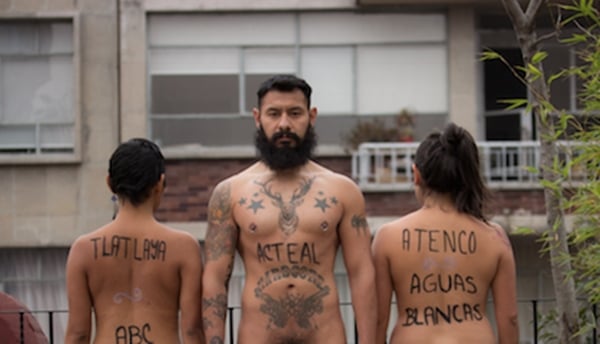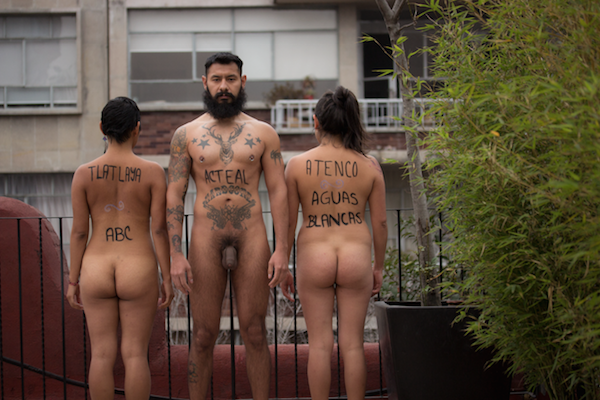Art World
artnet Asks: Mexican Photographer and Activist Édgar Olguín
His powerful series of nude human billboards condemns the killing of 43 Mexican students.

His powerful series of nude human billboards condemns the killing of 43 Mexican students.

Lorena Muñoz-Alonso


From the Poner el cuerpo: sacar la voz series (2014-2015), by Édgar Olguín
Photo via: Tumblr
Photographer Édgar Olguín (Mexico City, 1983) hit the headlines last month when he released his powerful photographic series Poner el cuerpo: sacar la voz (to show one’s body, to raise one’s voice). The project condemns the killing of 43 students who were attending a demonstration in the Mexican city of Iguala last September, seen by many as a collusion between government officials and organized crime (see Naked Youths Take to Mexican Streets to Protest Student Killings Documented by Édgar Olguín).
The young photographer declared, “In contemporary society, a naked body has become a more alarming sight than a burned cadaver on a front page.” artnet News got in touch with Olguín to discuss the project and the role of art as a social tool.
With a mix of melancholy and absolute determination, Olguín explained why it’s important to speak up in times of crisis and why he sees his project as a collective accomplishment, not an individual success.
How did Poner el cuerpo: sacar la voz begin?
My idea was to bring to the streets all these slogans and chants shared on social media in reaction [to the killings]. I wanted to bring those slogans to life and action. This is how the idea of the human billboards came about. For us, protest billboards are like screams pinned to the walls, and we decided to use the naked body and play with urban spaces to make these screams heard in a society that is behaving passively towards the realities of the country.
Mexico is a dangerous country, and the 43 killed students are the most disturbing and recent testimony of that. Have you ever been afraid of doing your work?
Artists are the chroniclers of their own time and history, and living in this world is a danger in itself, anyway. If you avoid talking about the problematic things happening around you, you’re already being complicit. I am convinced that art is an effective social tool.
What were you seeking to represent with these images?
We wanted to depict everyday life but also solitude, which is the feeling I get after a demonstration. As protestors, we walk together but we don’t know where we want to go. And, even when we know where we want to go, we don’t know how to get there together, so, with this project, we wanted to stand apart from rallies and demonstrations. We wanted to use everyday spaces to represent the free circulation of both people and ideas, which is being threatened by the Mexican State today.
How did you find the people that appear in the photos?
The models are actors, friends, and people that other friends introduced me to when they heard about the project, and who immediately decided to participate in it by lending their bodies. We have all formed a close-knit group now.

From the Poner el cuerpo: sacar la voz series (2014-2015), by Édgar Olguín
Photo via: Tumblr
What sort of reactions have you encountered?
The comments I’ve heard are usually positive and encouraging, although I am sure some people will dislike the work, too. Also, the American photographer Spencer Tunick [best known for organizing large-scale nude shoots] emailed one of my models to praise her for her bravery.
You have said that it was important for you that this project wasn’t commodified, which is why you released it on a Tumblr page. Have you had any offers to display it on commercial galleries since?
I decided to use Tumblr to avoid the censorship prevalent in platforms such as Facebook (see L’Origine du Monde Sparks Facebook Legal Battle) and Instagram (see Instagram Apologizes to Artist Over Topless Cartoon Ban). Tumblr accepts even pornography. I wanted to release it online because a work of art that is fighting for freedom of expression should not be enclosed by the four walls of a gallery. I didn’t want to commercialize a project that wasn’t born out of greed, but from the heart and the guts. Everyone involved has contributed to it pro bono. But yes, I have received offers to show the series in galleries, three from Mexico and one from Miami.
How was the process of shooting in the streets?
It was a complex one, and each location required a specific production team. We even had to hire a legal consultant, as being naked in a public space here in Mexico is considered a crime.
Tell me about your previous work: do you consider yourself a fine art photographer or a documentary photographer?
I am social photographer, a human photographer. Previous subjects that I have covered include gender and political issues, as well as sexual harassment on the streets. Since 2009, I’ve been studying documentary filmmaking.
Who has most influenced you artistically?
The most human of the human beings. For example: Vincent van Gogh, Pablo Picasso, Silvio Rodríguez, Joseph Beuys, the kids of my country, Christian Boltanski, Banksy, BLU, Jorge Izquierdo, Yoko Ono, John Cage, Joan Miró, Jean-Michel Basquiat, Diane Arbus, Juan Rulfo, Rufino Tamayo, David Alfaro Siqueiros, Tina Modotti, Mariana Yampolski, Manuel Álvarez Bravo, Héctor García, Francisco Toledo (see Mexico’s Revered Artist Francisco Toledo Donates His Private Museum to the State), Jan Saudek, Sebastião Salgado, Julio Cortázar, Pablo Neruda, Charles Bukowski, Mario Benedetti, Gabriel García Márquez, Efraín Huerta, and Calle 13.
After the 43 killings, how do you feel as a Mexican citizen?
As Mexican, I feel the need to keep moving and working. As long as there is a sensitive ear or gaze to reach, there will be a photo to take.

From the Poner el cuerpo: sacar la voz series (2014-2015), by Édgar Olguín
Photo via: Tumblr